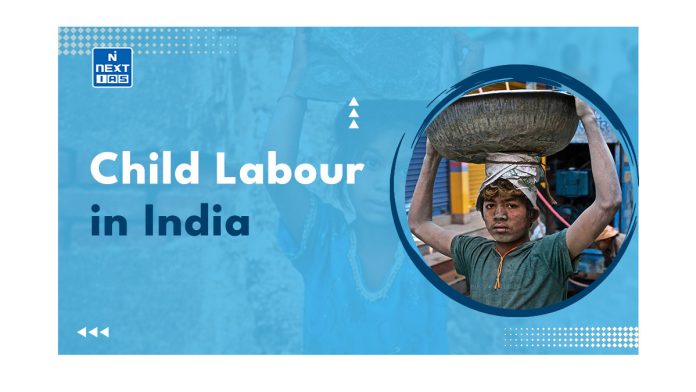Child Labour means when children are made to work in a way that takes away their childhood, potential, and self-respect.
- It includes work that is dangerous or harmful to children’s physical, mental, social, or moral well-being.
- It also includes work that stops them from going to school, either by not allowing them to attend or by forcing them to leave early.
Whether a particular type of work is considered child Labour depends on factors like the child’s age, the kind and hours of work, the conditions in which it takes place, and the rules set by each country. The definition may vary from country to country and even within different industries within a country.
Facts and Statistics of Child Labour in India
- Total child population (5-14 years) in India: 259.6 million (Census 2011).
- Working children in India: 10.1 million (3.9% of the total child population) as “main workers” or “marginal workers.”
- Out-of-school children in India: more than 42.7 million.
- Child Labour decreased in India by 2.6 million between 2001 and 2011.
- The decline is more visible in rural areas, while the number of child workers increased in urban areas, indicating a growing demand for child workers in menial jobs.
Causes of Child Labour
| Poverty Poverty is the single biggest cause of this issue in India. Children from poor families often have to work to help support their families financially. They may work in factories, on farms, or in the informal economy. |
| Lack of access to Quality Education Many children in India do not have access to good schools. When children do not have access to quality education, they are more likely to work instead of going to school. |
| Growth of the Informal Economy: The informal economy is made up of small businesses and self-employed workers. The informal economy often employs them because it is difficult to enforce child Labour laws in the informal sector. |
| Lack of Awareness Most parents are unaware of the physical, mental, and psychological ill consequences of this issue. |
There are many other factors that contribute to the problem, such as social norms, cultural beliefs, and discrimination.
Consequences of Child Labour
The consequences faced have a far-reaching impact on the child, society, and the nation as a whole:
| Child Consequences: Health Risks: This exposes children to hazardous working conditions, physical and mental abuse, and long hours of Labour, which can result in injuries, illnesses, and developmental issues. Education Deprivation: Working children are often denied access to education, leading to a lack of basic literacy, limiting their future opportunities, and perpetuating the cycle of poverty. Stunted Development: It disrupts normal childhood development, depriving children of playtime, social interaction, and emotional well-being, hindering their physical, cognitive, and emotional growth. |
| Societal Consequences: Undermining Human Rights: It violates the fundamental rights of children, denying them the right to education, protection, and a safe and healthy environment. Poverty and Inequality: It keeps families trapped in a cycle of poverty, as children’s earnings contribute minimally to the household income and hinder their long-term economic prospects. Social Disintegration: It disrupts family and community dynamics as children are forced into work instead of receiving proper care and education. This can lead to a breakdown in social structures and intergenerational poverty. |
| National Consequences: Economic Implications: It deprives children of education, leading to a less skilled workforce, reduced productivity, and limited opportunities for economic advancement. Human Capital Loss: It results in the loss of potential human capital as children are denied education and skill development. This diminishes the nation’s capacity to compete globally and achieve sustainable development goals. Social Welfare Burden: The physical and psychological consequences lead to increased healthcare and social welfare costs for the nation. Governments must allocate resources to address these issues, diverting funds from other critical areas. |
Solutions to the Issue of Child Labour in India
Addressing the issue of child Labour in India requires a comprehensive approach involving various stakeholders.
- Strengthening Legislative Framework: Enforce and strengthen existing laws, such as the Child Labour (Prohibition and Regulation) Act, to ensure comprehensive protection for children and stricter penalties for offenders. Amendments should align with international standards.
- Access to Quality Education: Ensure universal access to free and quality education for all children. Implement and enforce the Right to Education Act, focusing on reducing dropout rates and increasing enrollment in schools.
- Poverty Alleviation: Tackle the root causes of child Labour by implementing poverty alleviation programs, providing economic support to families living in poverty, and promoting livelihood opportunities for parents.
- Awareness and Sensitization: Conduct widespread awareness campaigns targeting parents, communities, and employers about the detrimental effects of child Labour on children’s physical, mental, and educational development.
- Rehabilitation and Social Protection: Develop and implement comprehensive rehabilitation programs for rescued child laborers, including access to education, vocational training, healthcare, and psychological support. Establish social protection schemes for vulnerable families to prevent children from entering the Labour force.
- International Cooperation: Collaborate with international organizations, such as the International Labour Organization (ILO) and UNICEF, to access expertise, technical assistance, and financial resources to combat child Labour effectively.
- Empowering Local Communities: Involve local communities, including parents, teachers, and community leaders, in preventing child Labour. Empower them to identify and report cases of child Labour and provide support for rehabilitation and reintegration efforts.
It is important to recognize that addressing child Labour is a complex and multifaceted issue that requires sustained efforts, collaboration, and the commitment of all stakeholders to create lasting change.
Conclusion
Addressing and eliminating child Labour is crucial for the well-being of children, the progress of society, and the sustainable development of a nation.
It requires concerted efforts, comprehensive policies, and the active involvement of various stakeholders to ensure the protection of children’s rights and their holistic development.
FAQs
How Many Children are Presently Working as Labour in India?
There are around 10.1 million (3.9% of the total child population) as “main workers” or “marginal workers.”
What is the Major Reason for Child Labour in India?
The major reason for child Labour in India is poverty. Families living in poverty often resort to child Labour as a means of survival, as children can be paid less and are more vulnerable to exploitation.
What are the 10 Causes of Child Labour?
The 10 causes of child Labour include poverty, lack of access to education, limited enforcement of child Labour laws, cultural attitudes and norms, armed conflict, discrimination, inadequate social protection, migration, globalization, and demand for cheap Labour.









